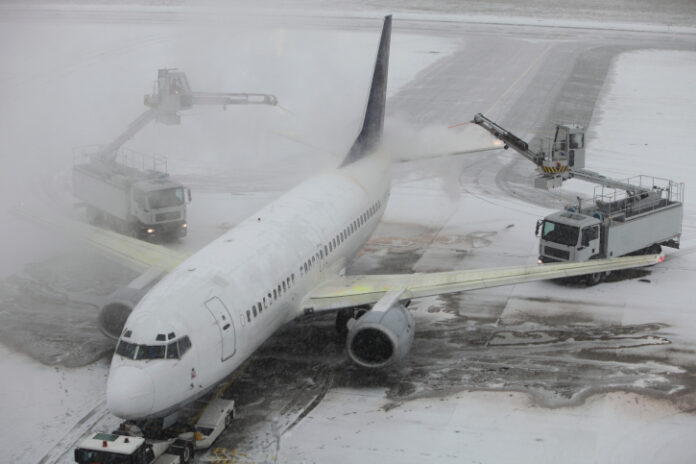The administration of President Donald Trump has announced it is imposing standards for aviation greenhouse gas emissions on domestic airplane manufacturers, a move intended to comply with the standards set by the U.N.’s International Civil Aviation Organization (ICAO), of which the United States is a member.
The global standard was adopted by the ICAO governing council in 2016, and endorsed by all ICAO member states as an international standard in 2017.
The announcement to set domestic limits on aviation emissions was a bit unexpected from the Trump administration, which has generally avoided international agreements on greenhouse gas emissions.
The standard announced by the U.S. Environmental Protection Agency requires all airplanes designed by domestic airplane manufacturers on or after January 1, 2020 to produce 4 percent less carbon dioxide emissions below levels emitted by aircraft in 2015. The standard also applies to all airplanes in production on or after January 1, 2028—giving U.S. manufacturers a five year longer period to meet the international standards than the 2023 date set by the ICAO. Airplanes currently in-use or that come into use during the intervening period are not required to meet the new standard.
The proposed rule is now undergoing the required review process and comment period, which must be completed before it is finalized and becomes official.
EPA Response
In EPA’s press release announcing the aviation emission proposal, the agency notes ICAO’s standards were developed “with significant input from EPA, the Federal Aviation Administration (FAA), and U.S. and international aviation industries.”
Three quarters of the aircraft manufactured in the United States are sold internationally, thus EPA says it proposed making the standard a domestic requirement to ensure consistent standards across the world, and to allow U.S. manufactured planes to continue to compete in the global marketplace.
“This standard is the first time the U.S. has ever proposed regulating greenhouse gas emissions from aircraft,” said EPA Administrator Andrew Wheeler. “Along with the Affordable Clean Energy and Safer Affordable Fuel-Efficient Vehicle rule, this is the Trump Administration’s third major action to take sensible, legally defendable steps to regulate greenhouse gases, while safeguarding American jobs and the economy.”
Environmental Groups Want More
Shortly after the rule was proposed, a variety of environmental groups claimed the rule does not go nearly far enough to combat so-called climate change.
Reuters reports the Center for Biological Diversity’s (CBD) climate legal director, Clare Lockwood, called the proposed rule a “toothless proposal does nothing to meaningfully address the serious problem of airplanes’ planet-warming pollution.” Lockwood went on to say in a CBD press release the rules “are ‘too weak’ to address the severity of the climate crisis.”
Airplane Manufactures Support Regulation
Despite the fact that airplane manufacturers were already improving fuel efficiency and reducing emissions, having improved fleet fuel economy by 40 percent between 2000 and 2019 and having cut carbon dioxide emissions by 50 percent over the past 30 years, Airlines for American (A4A), an aviation industry trade group, said in a press release the rule was necessary to keep international markets open for U.S. manufactured airplanes, because “without the standard, the aircraft would not be able to get critical certifications necessary for international operations.”
“EPA’s proposal to adopt ICAO’s fuel efficiency and CO2 certification standard for newly manufactured aircraft is good for our industry, for our country and for the world,” Nancy Young, A4A vice president, environmental affairs, said the organization’s press release. “Although the U.S. airlines are already driven to be highly fuel- and carbon-efficient, this stringent new emissions standard will help U.S. airlines make a green industry even greener.”
This rule promotes the domestic aircraft industry while also protecting the environment, said Bryan Watt, a spokesperson for Boeing, according to the New York Times.
“[The rule] a major step forward for protecting the environment and supporting sustainable growth of commercial aviation and the United States economy,” Watt said.
Unnecessary, Slippery Slope
It is unclear why a federal regulation is necessary to certify manufacturers meet the ICAO standards, says H. Sterling Burnett, Ph.D., a senior fellow for The Heartland Institute.
“If American airplane manufacturers are worried they will lose access to foreign markets unless they comply with the international standards, they can just adapt their practices and comply,” said Burnett “Nothing prevents manufacturers of any products sold internationally from meeting a foreign country’s particular standards or international standards in general, indeed they adapt their products and packaging to local markets all the time, so, they don’t need a U.S. law or regulation forcing them to do so.”
Burnett says, aside from being unnecessary, by adopting federal regulations restricting greenhouse gas emissions for the first time ever on the aviation industry, the Trump administration is setting itself up to be forced to impose ever greater emission regulations on a broad range of industries to fight climate change, which Trump has referred to as a “hoax.”
“It is shameful and discouraging that the Trump administration, of all presidential administrations one can imagine, is taking the lead on imposing greenhouse gas limits on aircraft manufacturers,” said Burnett. “There is little evidence humans are causing climate change and this decision plays into the hands of power-seeking climate alarmists, who can now say ‘if aviation greenhouse gas emissions are dangerous meriting restrictions, then cars, cows, factories, and power plants are even worse emitters, so the Trump administration should adopt stricter targets on those rather than rolling back emission reduction plans set under former-President Obama.’”
Chris Talgo (ctalgo@heartland.org) is an editor at The Heartland Institute.

























